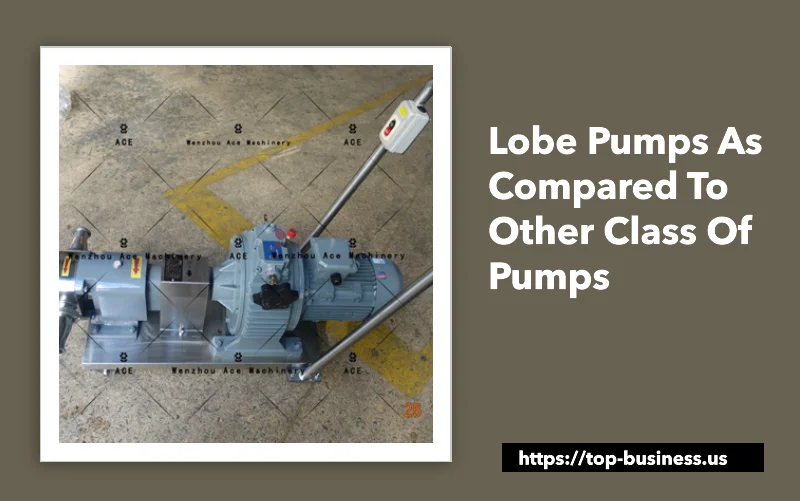The choice of a particular pump is vital, most especially in industrial applications. This is due to the fact that the design and functionality of the various pumps influence the specific functions that they are able to achieve. In terms of pumping fluids with high viscosity and shear-sensitive materials, a lobe pump has its strong advantages. In order to guarantee optimum and efficient working circumstances in all domains, one needs to know the differences between lobe pumps and other classifications of pumps.
Basics of Lobe Pumps
A lobe pump is a positive displacement pump, and its operation involves the action and interaction of rotating vanes. Like other technology, inlet and outlet impediments encountered in the run of a lobe pump consist of some aspects that retard the active functioning of the components. Still, leakage occurs; however, the effect of inducing hydraulic slide bearing by rotating one rotor to the other is damped, thus the leakage is minimal. It signifies a positive induction in a pipeline or siphon attaching within a device.
Geometric Characteristics
Apart from nine rotors, twelve vanes are judiciously disposed and secured, each within a housing. The lateral lobes work well without colliding or touching each other, allowing for the rotation of the swash plate without friction. This design allows handling of high viscous fluids. Due to the reason of these lobes not contacting each other, there are larger spaces, which allow for bigger contents. A lobe pump provides an outflow from a pump system in the form of a continuous and steady stream without any pulsation. This property is very important in sustaining the motion of certain fluids in one direction.
Common Applications
These pump types allow for the easy manufacturing of food and pharmaceutical products since they are compatible with shear-sensitive materials. In order to assist in the removal of dense substances, a lobe pump is structured accordingly. This way, its usage can be extended to chemical and sewage treatment. A lobe pump has a high range of working activities in different economic sectors.
Advantages of Lobe Pumps
Gentle Fluid Transport and Relocation
Lobe pumps stand out in several areas given the practice of lobe pumping. This type of construction minimizes shear forces, which usually damage delicate materials. These features help in the manufacturing of industries with difficult fluid control systems. Such materials do not get damaged while being moved from one place to another.
Diverse Applications
A common characteristic that most users of lobe pumps observe is their wide range of applications. Control of both high-viscosity liquids and solids is easily done. Operating conditions of a lobe pump are optimal, which accounts for its use in a wide range of industries. Recent improvements allow for cutting and shaping multiple materials in one operation.
Limitations of Lobe Pumps
Cost Implications
When purchasing a lobe pump, the initial cost is a significant concern. Construction costs are further heightened due to the advanced nature of the system. A lobe pump may involve spending more than on other simpler pump configurations. These factors must be considered when deciding on equipment for specific tasks.
Maintenance Capabilities
Lobe pump maintenance is rather complex. The interdependent control systems and motion mechanisms are highly complicated. Good maintenance management can improve reliability, but it may also lead to increased maintenance costs over time.
Overview of Other Pump Types
Centrifugal Pumps
General Characteristics and Operation
Fluid is transferred by centrifugal pumps with the aid of a rotating impeller. The impeller generates centrifugal pressure on the fluid, forcing it outwards. This increases the flow rate of the liquid, making centrifugal pumps effective for low-viscosity fluids.
Common Applications
Centrifugal pumps are widely used in utility water supply systems, HVAC systems, and chemical processing plants due to their simple structure and ease of maintenance.
Diaphragm Pumps
Design and Functionality
Diaphragm pumps use a flexible diaphragm to relocate fluid within an enclosure. The diaphragm creates a negative pressure to draw in fluid, which is then expelled during the discharge phase. Diaphragm pumps are effective in pumping corrosive and abrasive liquids.
Common Applications
Diaphragm pumps are commonly used in the chemical sector, wastewater treatment, and food industries due to their ability to handle harsh and abrasive materials while maintaining hygiene.
Comparisons Between Pump Types
Lobe Pumps vs. Gear Pumps
Performance
Lobe pumps produce a more uniform flow with fewer pulsations compared to gear pumps, making them ideal for transferring highly viscous liquids. Gear pumps may induce more pulsation but are effective for moderate viscosity applications.
Lobe Pumps vs. Centrifugal Pumps
Lobe pumps handle viscous fluids more efficiently, while centrifugal pumps are better suited for low-viscosity liquids and high-shear applications.
Suitability
Lobe pumps are well-suited for industries requiring flow control and are used in the cosmetics and chemical sectors. Centrifugal pumps are ideal for water treatment plants and applications where high flow rates are necessary.
Selection Criteria for Pumps
Fluid Type
When choosing a pump, fluid type is a key consideration. High-viscosity and abrasive fluids may require lobe pumps, while low-viscosity liquids are better suited for centrifugal pumps.
Pressure and Flow Rate
The pressure and flow rate requirements help determine the appropriate pump type. High-pressure applications may require robust pump constructions, while steady flow ensures optimal performance.
Environmental Considerations
Temperature and corrosive conditions influence pump selection. Heat-resistant materials are necessary for high-temperature environments, while chemically inert materials like stainless steel are ideal for corrosive conditions.
Cost-Benefit Analysis
Initial Investment
Lobe pumps typically have higher upfront costs compared to other pump types, but they offer long-term benefits in specific applications. Centrifugal pumps have a simpler design, leading to reduced initial costs.
Long-Term Costs
Lobe pumps have lower operational and maintenance costs over time compared to more complex systems like turbine pumps, making them cost-effective in the long run.
Industry-Specific Applications
Food and Beverage Industry
Lobe pumps are commonly used in food and beverage processing due to their ability to handle delicate materials without causing damage or contamination.
Chemical Processing
Lobe pumps create value in chemical processing, especially for handling high-viscosity fluids. Diaphragm pumps are used for corrosive fluids, while centrifugal pumps are effective for low-viscosity bulk applications.
Conclusion
Lobe pumps provide significant advantages for handling viscous and shear-sensitive fluids across various industries. Compared to other pump types, they offer gentle fluid transport, diverse applications, and long-term cost benefits, making them a valuable choice in specific industrial contexts.








